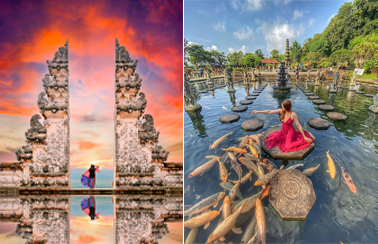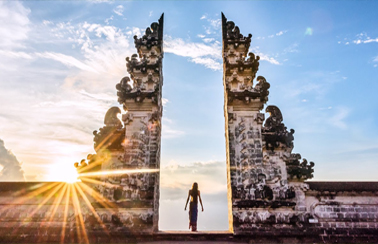What is Lempuyang Temple and why is it significant?
Lempuyang Temple, also known as Pura Lempuyang Luhur, is a sacred Balinese Hindu temple situated on the slopes of Mount Lempuyang. It holds deep spiritual significance and is considered one of Bali's holiest sites. The temple complex consists of seven ascending temples, each representing a different stage of spiritual ascent.
How do I get to Lempuyang Temple from popular tourist areas?
Reaching Lempuyang Temple requires a journey to the eastern part of Bali. From popular tourist areas like Ubud or Kuta, it's best to arrange transportation, such as a private driver or guided tour, to ensure a hassle-free trip. The scenic drive offers glimpses of Bali's rural charm, lush landscapes, and traditional villages, making the journey as enchanting as the destination itself.
What is the entrance fee for Lempuyang Temple?
As of 2023-2024, the entrance fee for Lempuyang Temple is 100,000 IDR ($7 USD) per person. This fee also includes the services of a photographer to capture your visit against the iconic "Gate of Heaven" backdrop.
Are there any additional fees for visiting Lempuyang Temple?
Yes, apart from the entrance fee, there is a shuttle service available for 50,000 IDR ($3.50) per person, which takes you to the top of the mountain where the temple entrance is located.
What can I expect during my visit to Lempuyang Temple?
The journey involves ascending a series of steep steps, offering stunning views and opportunities to pause at various temples and resting points. The temple's architecture, including the famous "Gate of Heaven," provides excellent photo opportunities. Additionally, you can immerse yourself in the temple's rituals and spiritual ambiance.
What are the best times to visit Lempuyang Temple for photography?
Morning visits offer serene and mystical atmospheres, with soft lighting illuminating the temple's intricate details and fewer crowds. Afternoon visits provide a chance to capture the temple in the warm glow of the setting sun. Regardless of the time, the temple's allure remains captivating.
Are guided tours available for Lempuyang Temple?
Yes, guided tours are available and highly recommended for a deeper understanding of the temple's history and significance. These tours often include entrance fees, transportation, and may be combined with visits to other nearby attractions, offering a comprehensive Bali experience.
What is the temple's opening hours?
Lempuyang Temple is open for visitors daily from 7am to 7pm. However, it's important to note that it is open 24 hours for worship purposes.
Can I find nearby accommodations and attractions?
Yes, there are various nearby hotels, attractions, and restaurants to enhance your visit. You can explore options for accommodations, nearby places of interest, and dining experiences to complete your Bali journey.
How many steps are there in Lempuyang Temple?
The ascent to Lempuyang Temple involves climbing a series of steep steps. While the exact number may vary, it's estimated that there are around 1,700 steps to reach the highest temple. The challenging climb is rewarded with breathtaking views and a sense of accomplishment upon reaching the top. Resting points and smaller temples along the way offer opportunities to catch your breath and admire the surroundings.
How long do you need in Lempuyang Temple?
The amount of time you'll spend at Lempuyang Temple depends on your pace and interests. On average, visitors often spend around 1 to 2 hours exploring the temple complex. This duration allows you to ascend the steps, appreciate the architecture, take photographs at the "Gate of Heaven," and soak in the spiritual ambiance. However, if you wish to thoroughly explore and immerse yourself in the surroundings, you may choose to spend more time at the temple. Keep in mind that the temple's opening hours and any additional activities, such as guided tours or rituals, can also influence the duration of your visit.
Is it worth it to go to Lempuyang Temple?
Absolutely, visiting Lempuyang Temple is a truly worthwhile experience for several reasons. The temple's spiritual significance, breathtaking architecture, and stunning panoramic views make it a must-visit destination in Bali. The iconic "Gate of Heaven" is not only a striking photography spot but also a symbol of connection between the earthly and the divine. The journey to the temple itself, though involving steep steps, offers a sense of achievement and rewards you with awe-inspiring vistas. Whether you're seeking cultural enrichment, spiritual reflection, or simply a memorable adventure, Lempuyang Temple offers an experience that's bound to leave a lasting impression.
Is Gates of Heaven Bali worth visiting?
Yes, the Gates of Heaven at Lempuyang Temple in Bali is definitely worth visiting. This iconic spot offers more than just a visually striking backdrop for photographs. The "Gate of Heaven" frames the majestic Mount Agung and holds deep spiritual significance in Balinese Hinduism. Beyond its visual appeal, it invites visitors to reflect on the interplay between the sacred and the earthly. The journey to the Gates of Heaven also adds to the experience, as you ascend the steps and immerse yourself in the temple's spiritual ambiance. Whether for its cultural significance, architectural beauty, or the opportunity to capture stunning images, the Gates of Heaven is a destination that resonates on multiple levels, making it a worthwhile addition to your Bali itinerary.
Why is Lempuyang Temple so important?
Lempuyang Temple, also known as Pura Lempuyang Luhur, holds immense importance in Balinese culture and spirituality. Situated on the slopes of Mount Lempuyang, the temple is one of Bali's holiest sites and is revered as a key point of connection between the human realm and the divine. Its seven ascending temples symbolize the spiritual journey from the material world to the spiritual realm. The temple's "Gate of Heaven" frames the towering Mount Agung and is not only a picturesque sight but also a symbol of harmony and unity in Balinese Hinduism. The rituals, ceremonies, and deep-rooted traditions associated with Lempuyang Temple highlight its significance as a center of devotion, reflection, and cultural heritage, making it an integral part of Bali's spiritual landscape.
How many steps are there in Lempuyang Temple?
Lempuyang Temple, also known as Pura Lempuyang Luhur, is one of Bali’s oldest and most revered temples. It is famously known as the "Gateway to Heaven" due to its stunning gateway and the views of Mount Agung through the gate. To reach the main temple at the summit, visitors need to climb approximately 1,700 steps. The climb can be physically demanding, but many find it rewarding due to the panoramic views and the serene and spiritual atmosphere at the top.
Is Lempuyang Temple worth it?
Yes, for many visitors, Lempuyang Temple is worth the visit, offering a unique blend of cultural insight, stunning views, and memorable photographic opportunities, despite the potential drawbacks of travel time and crowds.
Are there monkeys at Lempuyang Temple?
Yes, like many temples in Bali, Lempuyang Temple is home to a population of long-tailed macaques or Balinese monkeys. Visitors should be cautious with their belongings, as these monkeys are known for being curious and sometimes mischievous, particularly if they spot food or shiny objects. Following guidelines and respecting the animals' space helps ensure a pleasant visit.
What do you wear to Gates of Heaven Bali?
When visiting the Gates of Heaven at Lempuyang Temple in Bali, it is essential to dress modestly and respectfully, as it is a significant religious site. Visitors are generally advised to wear a sarong, covering the legs below the knee, and a sash around the waist. Wearing modest clothing that covers the shoulders and knees is also necessary. It is recommended to wear comfortable, easily removable footwear as you will need to take off your shoes before entering certain areas of the temple. Carrying a hat, sunglasses, and sunscreen can also be helpful as Bali can be quite hot and sunny. Following these dress guidelines shows respect for the local customs and beliefs, ensuring a respectful and enjoyable visit.
Where is the gates of heaven located?
The Gates of Heaven is located at Lempuyang Temple, which is situated on the slopes of Mount Lempuyang in the Karangasem Regency of Bali, Indonesia. The temple is approximately two hours away from popular areas like Denpasar and Ubud, depending on traffic conditions. The Gates of Heaven is renowned for its stunning views of Mount Agung and the surrounding landscapes, making it a popular destination for both pilgrims and tourists.
Is Handara Gate and Lempuyang Temple same?
No, Handara Gate and Lempuyang Temple are not the same; they are two different locations in Bali, Indonesia. Lempuyang Temple, home to the Gates of Heaven, is a significant Hindu temple located on the slopes of Mount Lempuyang in Karangasem Regency. In contrast, Handara Gate is a picturesque entrance gate to the Handara Golf & Resort Bali, located in the Bedugul highlands in the central part of the island. Both sites are popular photo spots for visitors, but they have different backgrounds and are situated in distinct regions of Bali.
How much time do you need at Lempuyang Temple?
Visitors typically spend around 2 to 3 hours at Lempuyang Temple, but the duration can vary depending on individual interests and pace. This time allows for exploring the temple complex, taking photographs, particularly at the Gates of Heaven, and soaking in the serene atmosphere and views. Additionally, visitors should factor in travel time, which can be approximately two hours each way from popular areas like Denpasar and Ubud, depending on traffic. It's also worth considering that there are over 1,700 steps to reach the top temple, so those planning to explore the entire complex should allocate additional time and be prepared for a physical exertion.
How is the Lempuyang Temple photo trick achieved?
The famous “floating” or reflection effect in photos at Lempuyang Temple’s Gates of Heaven is achieved using a simple mirror trick. A small, rectangular mirror is placed underneath the camera lens at a low angle. This mirror reflects the sky and the gate’s top, creating the illusion of a serene and perfectly reflective water surface, even though there is no water in front of the gate. This photographic trick has contributed to the site's popularity, as the resulting images often look mystical and surreal, attracting tourists seeking to capture a similar shot. However, visitors are advised to manage their expectations and be aware that the illusion is a crafted perspective rather than a natural reflection.
What time is best to visit Lempuyang Temple?
Visiting Lempuyang Temple at 6 am allows you to experience the serene beauty of the sunrise, offering spectacular photo opportunities at the "Gateway to Heaven" with Mount Agung in the backdrop. The early morning visit also means fewer crowds, enabling a more peaceful and contemplative experience. Alternatively, arriving at 5:30 pm offers a chance to witness a breathtaking sunset, casting a golden glow on the temple and creating a mystical atmosphere. Regardless of the time chosen, visiting during sunrise or sunset provides unique and unforgettable experiences at Lempuyang Temple.














